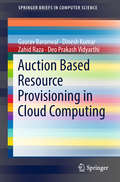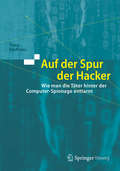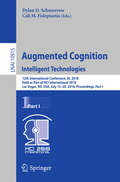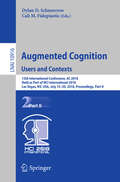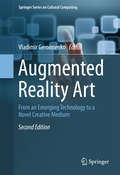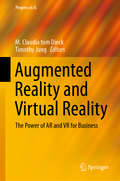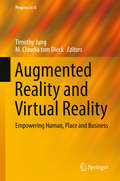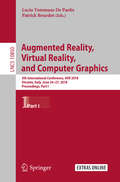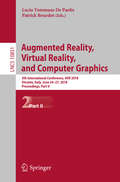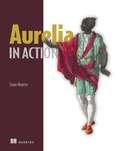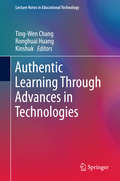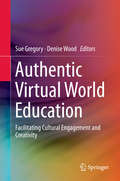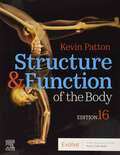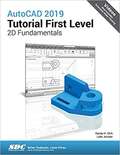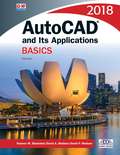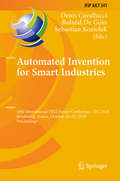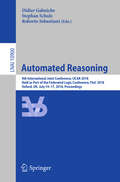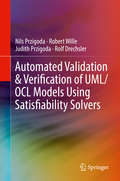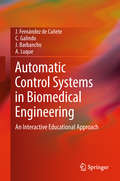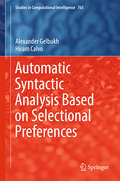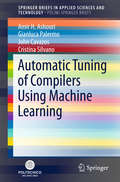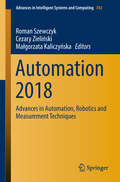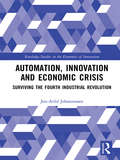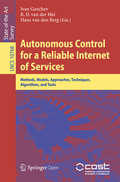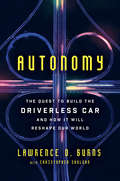- Table View
- List View
Auction Based Resource Provisioning in Cloud Computing (SpringerBriefs in Computer Science)
by Dinesh Kumar Gaurav Baranwal Zahid Raza Deo Prakash VidyarthiThe book, while introducing readers to the auction mechanism for resource provisioning in cloud computing, also endeavors to provide structured literature on the subject. Since various models have been proposed, it will help readers to formulate the cloud resource provisioning problem using the auction approach. The book also discusses challenges for resource provisioning in detail, helping to shape future research. The target audience for this book includes computer scientists, economists, industry professionals, research scholars, and postgraduate students. Computer science readers of this book will come to see that economics-based method are quite helpful in computer science, especially for resource provisioning. Readers with a cloud computing background will come to recognize the importance of dynamic pricing, the specific benefits of auctions, and how to formulate auctions for cloud computing. Lastly, readers from the economics community will come to understand their role in cloud computing, as well as where and how they can contribute.
Auf der Spur der Hacker
by Timo SteffensProfessionelle Hackerangriffe (sogenannte Advanced Persistent Threats) treffen heutzutage Regierungen, Unternehmen und sogar kritische Infrastrukturen wie Flughäfen oder Stromnetzbetreiber. Herauszufinden, welche Täter und Auftraggeber dahinter stecken, wird zunehmend wichtiger. Wenn man die Ursprünge eines Angriffs und seine Motive kennt, kann man sich besser schützen und die Konsequenzen eines Datendiebstahls effektiver begrenzen.Damit die Frage, ob ein Angriff aus Russland, China, einem anderen Land, oder von gewöhnlichen Kriminellen durchgeführt wurde, nicht eine Frage des Glaubens oder Bauchgefühls bleibt, soll dieses Buch einen Blick hinter die Kulissen der Ermittler und Analysten werfen. Ausführlich erläutert der Autor die IT-technischen Methoden, mit denen man den Tätern auf die Spur kommt, aber auch, wo diese Methoden an Grenzen stoßen. Zahlreiche Beispiele von aufwändigen Angriffen der letzten Jahre zeigen, wie die Täter falsche Fährten legen, oft genug aber auch Fehler machen, die sie überführen.So bietet der Autor, der seit mehreren Jahren gezielte Hackerangriffe von Spionagegruppen auf Behörden und Unternehmen untersucht, einen spannenden Blick hinter die Kulissen der Ermittler und Analysten. Neben Sicherheitsexperten staatlicher Behörden, Unternehmen, Stiftungen und NGOs, die regelmäßig zum Ziel von Cyberkriminalität werden, finden auch technische Journalisten und interessierte Laien in diesem Buch eine Fülle an Hintergrundwissen zur IT-Forensik.
Augmented Cognition: 12th International Conference, AC 2018, Held as Part of HCI International 2018, Las Vegas, NV, USA, July 15-20, 2018, Proceedings, Part I (Lecture Notes in Computer Science #10915)
by Dylan D. Schmorrow Cali M. FidopiastisThis two-volume set LNCS 10915 and 10916 constitutes the refereed proceedings of the 12h International Conference on Augmented Cognition, AC 2018, held as part of the 20th International Conference on Human-Computer Interaction, HCII 2018, in Las Vegas, NV, USA in July 2018. The 1171 papers presented at HCII 2018 conferences were carefully reviewed and selected from 4346 submissions.The papers cover the entire field of human-computer interaction, addressing major advances in knowledge and effective use of computers in a variety of applications areas. The papers in this volume are organized in the following topical sections: context aware adaption strategies in augmented cognition, brain sensors and measures for operational environments, artificial intelligence and machine learning in augmented cognition, augmented cognition in virtual and mixed reality.
Augmented Cognition: 12th International Conference, AC 2018, Held as Part of HCI International 2018, Las Vegas, NV, USA, July 15-20, 2018, Proceedings, Part II (Lecture Notes in Computer Science #10916)
by Dylan D. Schmorrow Cali M. FidopiastisThis two-volume set LNCS 10915 and 10916 constitutes the refereed proceedings of the 12h International Conference on Augmented Cognition, AC 2018, held as part of the 20th International Conference on Human-Computer Interaction, HCII 2018, in Las Vegas, NV, USA in July 2018. The 1171 papers presented at HCII 2018 conferences were carefully reviewed and selected from 4346 submissions. The papers cover the entire field of human-computer interaction, addressing major advances in knowledge and effective use of computers in a variety of applications areas. The papers in this volume are organized in the following topical sections:Cognitive modeling, perception, emotion and interaction, augmented learning and training, shared cognition, team performance and decision-making.
Augmented Reality Art: From An Emerging Technology To A Novel Creative Medium (Springer Series on Cultural Computing)
by Vladimir GeroimenkoThis is the second edition of the first ever book to explore the exciting new field of augmented reality art and its enabling technologies. The new edition has been thoroughly revised and updated, and contains 5 new chapters. As well as investigating augmented reality as a novel artistic medium the book covers cultural, social, spatial and cognitive facets of augmented reality art. Intended as a starting point for exploring this new fascinating area of research and creative practice it will be essential reading not only for artists, researchers and technology developers, but also for students (graduates and undergraduates) and all those interested in emerging augmented reality technology and its current and future applications in art.
Augmented Reality and Virtual Reality: Empowering Human, Place And Business (Progress in IS)
by Timothy Jung M. Claudia tom DieckThis book presents a collection of the latest research in the area of immersive technologies, presented at the International Augmented and Virtual Reality Conference 2018 in Manchester, UK, and showcases how augmented reality (AR) and virtual reality (VR) are transforming the business landscape. Innovations in this field are seen as providing opportunities for businesses to offer their customers unique services and experiences. The papers gathered here advance the state of the art in AR/VR technologies and their applications in various industries such as healthcare, tourism, hospitality, events, fashion, entertainment, retail, education and gaming. <P><P> The volume collects contributions by prominent computer and social sciences experts from around the globe. Addressing the most significant topics in the field of augmented and virtual reality and sharing the latest findings, it will be of interest to academics and practitioners alike.
Augmented Reality and Virtual Reality: Empowering Human, Place and Business (Progress in IS)
by Timothy Jung M. Claudia tom DieckThis volume provides the latest outcomes of augmented reality (AR) and virtual reality (VR) research conducted in various industries. It reveals how AR and VR are currently changing the business landscape, and how new innovations provide opportunities for businesses to offer their customers unique services and experiences. Collecting the proceedings of the International AR & VR Conference held in Manchester, UK, in February 2017, the book advances the state of the art in AR and VR technologies and their applications in various industries such as tourism, hospitality, events, fashion, entertainment, retail, education and the gaming industry. The papers presented here cover the most significant topics within the field of AR and VR for both researchers and practitioners, approaching them from a business and management perspective.
Augmented Reality, Virtual Reality, and Computer Graphics: 5th International Conference, AVR 2018, Otranto, Italy, June 24–27, 2018, Proceedings, Part I (Lecture Notes in Computer Science #10850)
by Lucio Tommaso De Paolis Patrick BourdotThe 2-volume set LNCS 10850 and 10851 constitutes the refereed proceedings of the 5th International Conference on Augmented Reality, Virtual Reality, and Computer Graphics, AVR 2018, held in Otranto, Italy, in June 2018. The 67 full papers and 26 short papers presented were carefully reviewed and selected from numerous submissions. The papers are organized in the following topical sections: virtual reality; augmented and mixed reality; computer graphics; human-computer interaction; applications of VR/AR in medicine; and applications of VR/AR in cultural heritage; and applications of VR/AR in industry.
Augmented Reality, Virtual Reality, and Computer Graphics: 5th International Conference, AVR 2018, Otranto, Italy, June 24–27, 2018, Proceedings, Part II (Lecture Notes in Computer Science #10851)
by Lucio Tommaso De Paolis Patrick BourdotThe 2-volume set LNCS 10850 and 10851 constitutes the refereed proceedings of the 5th International Conference on Augmented Reality, Virtual Reality, and Computer Graphics, AVR 2018, held in Otranto, Italy, in June 2018. The 67 full papers and 26 short papers presented were carefully reviewed and selected from numerous submissions. The papers are organized in the following topical sections: virtual reality; augmented and mixed reality; computer graphics; human-computer interaction; applications of VR/AR in medicine; and applications of VR/AR in cultural heritage; and applications of VR/AR in industry.
Aurelia in Action
by Sean HunterSummaryAurelia in Action teaches you how to build fantastic single-page applications with the Aurelia framework. You'll learn about modern design practices and a modular architecture based on web components, perfect for hybrid web + mobile apps.Purchase of the print book includes a free eBook in PDF, Kindle, and ePub formats from Manning Publications.About the TechnologyTry Aurelia, and you may not go back to your old web framework. Flexible and efficient, Aurelia enforces modern design practices and a modular architecture based on web components. It's perfect for hybrid web + mobile apps, with hot features like dynamic routes, pluggable pipelines, and APIs for nearly every flavor of JavaScript.About the BookAurelia in Action teaches you how to build extraordinary web applications using the Aurelia framework. You'll immediately take advantage of key elements like web components and decorators when you start to explore the book's running example: a virtual bookshelf. As the app unfolds, you'll dig into templating and data binding the Aurelia way. To complete the project, you'll take on routing and HTTP, along with tuning, securing, and deploying your finished product. What's InsideTemplating and data-bindingCommunication between componentsServer-side and SPA design techniquesView compositionAbout the ReaderWritten for developers comfortable with JavaScript and MVC-style web development.About the AuthorSean Hunter is a web developer with nearly 10 years of experience. He's extremely passionate about all things Aurelia and has been working with the framework in production since the early beta days. Sean got a taste for teaching developers how to get started with Aurelia while visiting user groups across the UK, and he's been excited to expand on this teaching effort with this book. These days, Sean is working in a variety of web-development technologies with companies across Australia, and he blogs at https://sean-hunter.io.Table of ContentsPART 1 - INTRODUCTION TO AURELIA Introducing AureliaBuilding your first Aurelia applicationPART 2 - EXPLORING AURELIAView resources, custom elements, and custom attributeAurelia templating and data bindinValue converters and binding behaviors Intercomponent communicationWorking with formsWorking with HTTPRoutingAuthenticationDynamic compositionWeb Components and AureliaExtending AureliaAnimationPART 3 - AURELIA IN THE REAL WORLD TestingDeploying Aurelia applications
Authentic Learning Through Advances in Technologies (Lecture Notes in Educational Technology)
by Kinshuk Ronghuai Huang Ting-Wen ChangThis book introduces the advanced technologies used for authentic learning, an educational term that refers to a variety of techniques focusing on how students apply the skills and knowledge acquired in school in real-world situations. In the meanwhile, it presents the latest trends and future developments in learning design, learning environment and assessment for authentic learning using advances in technology, this book discusses how technology supports authentic learning and what makes it effective.
Authentic Virtual World Education: Facilitating Cultural Engagement and Creativity
by Sue Gregory Denise WoodThe book presents the possibilities and realities of virtual worlds in education through the application of 3D virtual worlds to support authentic learning, creativity, learner engagement and cultural diversity in higher education. It includes a unique variety of cross disciplinary approaches to research, teaching and learning in a virtual world, including analysis of data from the experiences of students in education, law, Chinese language, sustainability, computer architecture, business, health and the Arts. The book provides unique learning experiences that have celebrated the rich media of virtual world environments through the utilisation of affordances such as simulation, bots, synchronous interaction, machinima and games. The perspectives come from Australia and New Zealand higher education academics but transferable to any higher educational institution in the sector, worldwide, and is significant to various disciplines in the higher education field.
AutoCAD and Its Applications Comprehensive 2018
by David A. Madsen David P. Madsen Terence M. Shumaker Craig P. Black Jeffrey A. Laurich J. C. MalitzkeAutoCAD and Its Applications: Comprehensive 2018 provides complete AutoCAD coverage. The Basics portion provides complete instruction in 2D drafting and AutoCAD tools and serves as a strong foundation for learning advanced AutoCAD topics. The Advanced portion builds upon the fundamental skills and techniques taught in the Basics portion. It provides detailed coverage of 3D modeling and other advanced topics, including 3D printing, point clouds, materials, lighting, rendering, and animation. AutoCAD and Its Applications: Comprehensive 2018 provides flexibility in course design and teaching approaches, supporting both introductory and advanced classes. This text provides a complete teaching program for 2D and 3D AutoCAD drafting and design. Whether you are learning AutoCAD for the first time or updating your skills, this book is a must.
Autocad 2019 Tutorial First Level 2d Fundamentals
by Randy ShihThe primary goal of AutoCAD 2019 Tutorial First Level 2D Fundamentals is to introduce the aspects of Computer Aided Design and Drafting (CADD). This text is intended to be used as a training guide for students and professionals. This text covers AutoCAD 2019 and the lessons proceed in a pedagogical fashion to guide you from constructing basic shapes to making multiview drawings. This textbook contains a series of eleven tutorial style lessons designed to introduce beginning CAD users to AutoCAD 2019. It takes a hands-on, exercise-intensive approach to all the important 2D CAD techniques and concepts. This text is also helpful to AutoCAD users upgrading from a previous release of the software. The new improvements and key enhancements of the software are incorporated into the lessons. The 2D-CAD techniques and concepts discussed in this text are also designed to serve as the foundation to the more advanced parametric feature-based CAD packages such as Autodesk Inventor.
Autocad And Its Applications Basics 2018
by David A. Madsen David P. Madsen Terence M. ShumakerAutoCAD and Its Applications: Basics 2018 provides complete instruction for mastering fundamental AutoCAD commands and drawing techniques. The text provides comprehensive coverage of AutoCAD 2D drafting and design. Topics are presented in an easy-to-understand sequence, building upon prior chapter knowledge. The heavily illustrated text not only tells you how to use AutoCAD, it also shows you how to use AutoCAD. In addition to teaching AutoCAD, this text serves as a valuable resource once you begin a career in the drafting and design industry.
Automated Invention for Smart Industries: 18th International TRIZ Future Conference, TFC 2018, Strasbourg, France, October 29–31, 2018, Proceedings (IFIP Advances in Information and Communication Technology #541)
by Roland De Guio Denis Cavallucci Sebastian KoziołekThis book constitutes the refereed proceedings of the 18th International TRIZ Future Conference on Automated Invention for Smart Industries, held in Strasbourg, France, in October 2018 and sponsored by IFIP WG 5.4.The 27 full papers presented were carefully reviewed and selected from numerous submissions. They are organized in seven thematic sections: teaching of TRIZ; TRIZ and knowledge represenations; biomimicry; strategic company management; association between TRIZ and other methods; TRIZ and the functional approach; and the use of patent or text populations as a data source.
Automated Reasoning: 9th International Joint Conference, IJCAR 2018, Held as Part of the Federated Logic Conference, FloC 2018, Oxford, UK, July 14-17, 2018, Proceedings (Lecture Notes in Computer Science #10900)
by Stephan Schulz Didier Galmiche Roberto SebastianiThis book constitutes the refereed proceedings of the 9th International Joint Conference on Automated Reasoning, IJCAR 2018, held in Oxford, United Kingdom, in July 2018, as part of the Federated Logic Conference, FLoC 2018. In 2018, IJCAR unites CADE, TABLEAUX, and FroCoS, the International Symposium on Frontiers of Combining Systems, and, for the fourth time, is part of the Federated Logic Conference.The 38 revised full research papers and 8 system descriptions presented together with two invited talks were carefully reviewed and selected from 108 submissions. The papers focus on topics such as logics, deductive systems, proof-search methods, theorem proving, model checking, verification, formal methods, and program analysis.
Automated Validation & Verification of UML/OCL Models Using Satisfiability Solvers
by Robert Wille Rolf Drechsler Nils Przigoda Judith PrzigodaThis book provides a comprehensive discussion of UML/OCL methods and design flow, for automatic validation and verification of hardware and software systems. While the presented flow focuses on using satisfiability solvers, the authors also describe how these methods can be used for any other automatic reasoning engine. Additionally, the design flow described is applied to a broad variety of validation and verification tasks. The authors also cover briefly how non-functional properties such as timing constraints can be handled with the described flow.
Automatic Control Systems in Biomedical Engineering: An Interactive Educational Approach
by J. Fernández de Cañete C. Galindo J. Barbancho A. LuqueThis book presents the fundamental principles and challenges encountered in the control of biomedical systems, providing practical solutions and suggesting alternatives. The perspective of the text is based on the system behaviour in the time domain both linear and non-linear, continuous and discrete, helping the reader to be able to interpret the physical significance of mathematical results during control system analysis and design focusing on biomedical engineering applications. Interactive learning is promoted, endowing students with the ability to change parameters and conditions during the simulation and see the effects of these changes, by using interactive MATLAB and SIMULINK software tools, also presenting realistic problems in order to analyse, design and develop automatic control systems. The text is also complemented with MATLAB and SIMULINK exercise files solved to aid students to focus on the fundamental concepts treated throughout the book, following a new pedagogical approach distinct from the classical one whereby fundamental control concepts are introduced together with adequate software tools in order to gain insight on the biomedical engineering control problems. The book is suitable for second or third-year undergraduate students who will find the illustrative examples particularly useful to their studies of control system design and implementation. Lecturers in the control field will find the computer aided design approach as an alternative to teaching the fundamental concepts of feedback analogic and digital control.
Automatic Syntactic Analysis Based on Selectional Preferences (Studies In Computational Intelligence #765)
by Alexander Gelbukh Hiram CalvoThis book describes effective methods for automatically analyzing a sentence, based on the syntactic and semantic characteristics of the elements that form it. To tackle ambiguities, the authors use selectional preferences (SP), which measure how well two words fit together semantically in a sentence. Today, many disciplines require automatic text analysis based on the syntactic and semantic characteristics of language and as such several techniques for parsing sentences have been proposed. Which is better? In this book the authors begin with simple heuristics before moving on to more complex methods that identify nouns and verbs and then aggregate modifiers, and lastly discuss methods that can handle complex subordinate and relative clauses. During this process, several ambiguities arise. SP are commonly determined on the basis of the association between a pair of words. However, in many cases, SP depend on more words. For example, something (such as grass) may be edible, depending on who is eating it (a cow?). Moreover, things such as popcorn are usually eaten at the movies, and not in a restaurant. The authors deal with these phenomena from different points of view.
Automatic Tuning of Compilers Using Machine Learning (SpringerBriefs in Applied Sciences and Technology)
by Cristina Silvano Gianluca Palermo John Cavazos Amir H. AshouriThis book explores break-through approaches to tackling and mitigating the well-known problems of compiler optimization using design space exploration and machine learning techniques. It demonstrates that not all the optimization passes are suitable for use within an optimization sequence and that, in fact, many of the available passes tend to counteract one another. After providing a comprehensive survey of currently available methodologies, including many experimental comparisons with state-of-the-art compiler frameworks, the book describes new approaches to solving the problem of selecting the best compiler optimizations and the phase-ordering problem, allowing readers to overcome the enormous complexity of choosing the right order of optimizations for each code segment in an application. As such, the book offers a valuable resource for a broad readership, including researchers interested in Computer Architecture, Electronic Design Automation and Machine Learning, as well as computer architects and compiler developers.
Automation 2018: Advances In Automation, Robotics And Measurement Techniques (Advances In Intelligent Systems And Computing #743)
by Roman Szewczyk Małgorzata Kaliczyńska Cezary ZielińskiThis book consists of papers presented at Automation 2018, an international conference held in Warsaw from March 21 to 23, 2018. It discusses the radical technological changes occurring due to the INDUSTRY 4.0, with a focus on offering a better understanding of the Fourth Industrial Revolution. Each chapter presents a detailed analysis of interdisciplinary knowledge, numerical modeling and simulation as well as the application of cyber-physical systems, where information technology and physical devices create synergic systems leading to unprecedented efficiency. The theoretical results, practical solutions and guidelines presented are valuable for both researchers working in the area of engineering sciences and practitioners looking for solutions to industrial problems.
Automation, Innovation and Economic Crisis: Surviving the Fourth Industrial Revolution (Routledge Studies in the Economics of Innovation)
by Jon-Arild JohannessenThe fourth industrial revolution is developing globally, with no geographical centre. It is also taking place at enormous speed. This development will shape the workplaces of the future, which will be entirely different from the workplaces created by the first, second and third industrial revolutions. Industry created the industrial worker. The knowledge society will create a new type of "industrial worker", the knowledge worker. While the third industrial revolution was concerned with the digitalization of work, in the fourth industrial revolution, robots will bring about the informatization of work. Many of these robots will be systematically connected, such that they can obtain updated information and learn from their own and others’ mistakes. The way we work, where we work, what we work on, and our relationships with our colleagues and employers are all in a state of change. The workplace of the future will not necessarily be a fixed geographical location, but may be geographically distributed and functionally divided. In his book, Jon-Arild Johannessen argues that a "perfect" social storm occurs when inequality grows at a catastrophic rate, unemployment increases, job security is threatened for a growing number and robotization takes over even the most underpaid jobs. Thus, the ingredients for a perfect social storm will be brought forward by cascades of innovations that will most likely lead to economic and social crises and he argues that it is reasonable to assume that it will only take a small spark for this social storm to develop into a social revolution.
Autonomous Control for a Reliable Internet of Services: Methods, Models, Approaches, Techniques, Algorithms, and Tools (Lecture Notes in Computer Science #10768)
by Ivan Ganchev R. D. van der Mei Hans van den BergThis open access book was prepared as a Final Publication of the COST Action IC1304 “Autonomous Control for a Reliable Internet of Services (ACROSS)”. The book contains 14 chapters and constitutes a show-case of the main outcome of the Action in line with its scientific goals. It will serve as a valuable reference for undergraduate and post-graduate students, educators, faculty members, researchers, engineers, and research strategists working in this field. The explosive growth of the Internet has fundamentally changed the global society. The emergence of concepts like SOA, SaaS, PaaS, IaaS, NaaS, and Cloud Computing in general has catalyzed the migration from the information-oriented Internet into an Internet of Services (IoS). This has opened up virtually unbounded possibilities for the creation of new and innovative services that facilitate business processes and improve the quality of life. However, this also calls for new approaches to ensuring the quality and reliability of these services. The objective of this book is, by applying a systematic approach, to assess the state-of-the-art and consolidate the main research results achieved in this area.
Autonomy: The Quest to Build the Driverless Car — And How It Will Reshape Our World
by Christopher Shulgan Lawrence BurnsAn automotive and tech world insider investigates the quest to develop and perfect the driverless car—an innovation that promises to be the most disruptive change to our way of life since the smartphoneWe stand on the brink of a technological revolution. Soon, few of us will own our own automobiles and instead will get around in driverless electric vehicles that we summon with the touch of an app. We will be liberated from driving, prevent over 90% of car crashes, provide freedom of mobility to the elderly and disabled, and decrease our dependence on fossil fuels. Autonomy is the story of the maverick engineers and computer nerds who are creating the revolution. Longtime advisor to the Google Self-Driving Car team and former GM research and development chief Lawrence D. Burns provides the perfectly-timed history of how we arrived at this point, in a character-driven and heavily reported account of the unlikely thinkers who accomplished what billion-dollar automakers never dared.Beginning with the way 9/11 spurred the U.S. government to set a million-dollar prize for a series of off-road robot races in the Mojave Desert up to the early 2016 stampede to develop driverless technology, Autonomy is a page-turner that represents a chronicle of the past, diagnosis of the present, and prediction of the future—the ultimate guide to understanding the driverless car and navigating the revolution it sparks.
